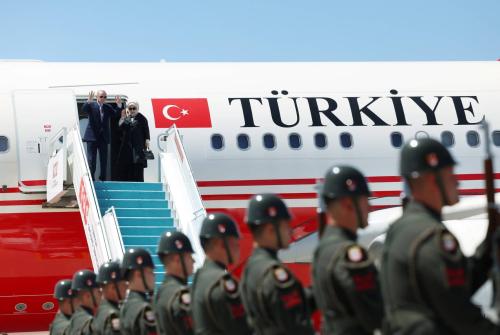Policymakers have long called for stronger U.S. crisis prevention structures that can avert a conflict before it escalates, and the current global environment, in which states are scrambling to expand their influence while international norms and institutions intended to prevent conflict are faltering, is only increasing this imperative. Unsurprisingly, we are witnessing a surge in violent conflict globally. The United States lacks the ability to stabilize all violent conflicts, and it is not necessarily in its interests to do so. But some of these conflicts—whether in Gaza, Ukraine, or the Sahel—are exhausting U.S. resources, emboldening revisionist actors, and threatening U.S. national security interests, even if they don’t present an imminent threat to the homeland. The United States must be better at managing these threats.
Research has demonstrated that preventative action is an efficient way to mitigate the risk of U.S. strategic overstretch and reduce violent conflict, especially when compared to costly and often ineffective efforts to stabilize a conflict that has already escalated. But implementing conflict prevention is extremely difficult. Preventative action faces inherent obstacles: individuals and organizations must overcome the natural tendency to focus their attention and resources on immediate threats and tame a bureaucratic bias against proactive action. These obstacles help explain why preventative action is often missing, too little, or too late.
In a recent paper—“Implementing prevention”—I propose a blueprint for a more practical, calibrated approach to implementing prevention within the U.S. government that is rooted in lessons learned from recent U.S. efforts and the realities of the U.S. bureaucracy. I examine the challenges facing the most ambitious U.S. conflict prevention initiative in recent years, the 2019 Global Fragility Act (GFA), and other prevention-oriented initiatives. I also use a case study of the U.S. failures to seize windows of opportunity to prevent the 2015 Yemen war to better understand how the United States’ ability to prevent conflict manifests in practice.
There are three elements that, in combination, are critical to an effective and practical conflict prevention approach, and which are lacking from existing conflict prevention initiatives:
1) Support for more adaptive, responsive U.S. foreign policymaking processes
The United States’ ability to mitigate the risk of conflict in other countries is typically rooted in significant policy decisions it makes at pivotal moments. In these cases, the United States must be able to quickly adapt its assumptions in the face of rapidly changing dynamics on the ground, weigh the medium-term costs of its decisions against immediate policy imperatives, elevate prevention as a priority, and mobilize the kind of senior-level attention necessary to enable decisive policy action. In my Yemen case study, I describe how the United States failed to weigh the significant medium-term consequences of the highly advantageous terms it supported for outgoing dictator Ali Abdullah Saleh in 2011, grasp the country’s collapsing political transition process in 2014 and the growing Houthi threat, and assess the consequences of its unqualified support for the Saudi-led coalition campaign in 2015 on Yemeni stability.
Standard U.S. policymaking processes—which were designed for the stable portfolios that make up the majority of U.S. bilateral relationships—instead tend to be slow and rigid, with a bias toward maintaining the status quo. Further, the United States often prioritizes global objectives like trade and counterterrorism (as was the case in Yemen) that may unintentionally exacerbate the risk of conflict. An effective conflict prevention initiative must provide the tools and authorities necessary to make policymaking processes more adaptive, responsive, and capable of challenging entrenched positions in the targeted countries. Doing so also requires strong support from policymakers across the foreign policy apparatus, which will only be possible if an initiative is actively helping advance top U.S. national security priorities.
Unfortunately, initiatives like the GFA often lack the necessary authorities and policymaker buy-in to influence U.S. foreign policy in the targeted countries. The decision to house the GFA in technical offices that lack authority over policymaking or all relevant foreign policy tools—particularly diplomatic engagement and security cooperation—and the relatively weak national security rationale for GFA efforts in the pilot countries all contribute to the constraints the GFA faces. Instead, the GFA is focused on foreign assistance projects that—in isolation—are incapable of shaping the trajectory of conflict at a national level. Experience from the U.S. atrocity prevention process and Middle East Partnership Initiative (MEPI), which were both hampered by weak policymaker buy-in, further underscores that a weak national security rationale will undermine the initiative’s impact, regardless of where it is institutionalized and how much initial support it has from senior U.S. officials or Congress. The State Department’s recently launched Policy Risk and Opportunity Planning group, which ties its planning exercises to countries with a defined, near-term national security imperative, provides a useful model for demonstrating a stronger strategic rationale and secure leadership support for preventative planning. However, it is not structured to alter existing policymaking processes in the targeted countries; instead, it provides a single point in a time planning exercise.
A more effective conflict prevention approach should be narrowly targeted toward conflicts that would explicitly threaten U.S. national security goals and where the United States has the influence and resources to positively shape the conflict’s trajectory. It should be overseen by a secretariat that coordinates staff from a series of offices across the U.S. government that have both formal authority over policymaking and technical expertise, with support from senior-level champions. Offices like the State Department’s Policy Planning Staff and the National Security Council’s Strategic Planning Directorate, which have global mandates for strategic planning and strong access to leadership, could play leading roles in such a secretariat. Finally, the initiative should establish practices that enable a critical assessment of existing U.S. policy in the targeted portfolios; integrate strategic foresight tools; develop a streamlined, whole-of-government strategic approach that elevates prevention and addresses trade-offs; and create regular opportunities for staff to challenge assumptions and identify new risks and opportunities.
2) A prevention pyramid: Balancing just-in-time and longer-term prevention with systemic reforms
The GFA and most other conflict prevention initiatives focus on long-term efforts that seek to address the underlying conditions that drive conflict, what experts call structural prevention. Such long-term efforts are most vulnerable to the inherent obstacles to preventative action noted above, however, and are practically difficult to maintain given U.S. political and bureaucratic timelines. Further, structural prevention typically demands transformative change in a country’s governance, economy, and social structures. U.S. failures in Iraq and Afghanistan over the past two decades have demonstrated that the United States cannot independently transform other countries, no matter how much time and effort it invests. Medium- to long-term prevention efforts are important, but they should only be part of a prevention initiative and restricted to countries where strong local leadership—including within the host-country government—already exists that U.S. efforts can reinforce.
Instead, “just-in-time” prevention efforts should serve as the initiative’s most targeted and visible element, the tip of the prevention pyramid. Just-in-time prevention efforts seek to change conflict actors’ behavior once a situation has already begun to escalate, what experts call operational prevention, using incentives, consequences, mediation, or even the threat of force. Such nearer-term efforts will have a more acute national security imperative and—if grounded in realistic, specific objectives—are more likely to demonstrate results in the near term, helping build policymaker buy-in. Research has also underscored operational prevention’s effectiveness.
Just-in-time and longer-term prevention efforts in select countries should be complemented by systemic bureaucratic reforms that mitigate impediments to preventative action—such as a highly restrictive diplomatic security posture and poor staffing structures in conflict-prone countries—and strengthen praxis around conflict prevention. These reforms could build on the State Department modernization agenda and should serve as the base of the prevention pyramid, establishing a stronger foundation for preventative action.
3) Prioritize operational resources
Operational resources, particularly funding and authorities to quickly hire skilled staff, are the most important resource for crafting more adaptive, responsive U.S. policymaking processes. They also effectively incentivize bureaucratic support for the initiative, recognizing that qualified staff are one of the scarcest resources of the offices overseeing U.S. policy in conflict-affected countries. None of the initiatives I examined provide significant, dedicated operational resources, however. The GFA and MEPI instead surge foreign aid funding. While often a useful tool, no foreign aid project in isolation can prevent war; as illustrated in the Yemen case study, U.S. influence instead depends on major policy decisions at key moments, such as in Yemen during 2011, 2014, and 2015, and the degree to which policymaking processes are sufficiently responsive and adaptive during those moments. Surging aid without operational resources can fuel the problematic tendency to projectize prevention efforts.
Dedicated operational funding combined with temporary hiring authorities1 should be used to strengthen existing structures like the State Department’s desks and embassies, with an emphasis on quality over quantity. Doing so requires a fraction of the funding needed to launch new foreign assistance programs and, in some cases, may be cost neutral. This could include hiring country experts from outside of government, surging support from conflict experts within the U.S. government, and regularizing and incentivizing interagency detail assignments to create a taskforce-like structure capable of tightening the alignment of military, diplomatic, economic, and intelligence tools. When a country is graduated from the initiative, these staff should be disbanded to avoid the proliferation of irrelevant and inefficient legacy systems. Strong congressional support is essential to enabling operational resources and sustaining a conflict prevention initiative across changes in administration, as seen with both the GFA and atrocity prevention process.
-
Acknowledgements and disclosures
The views expressed in this article are the author’s own, and not necessarily those of the U.S. government.
-
Footnotes
- This could include Schedule B authorities or use of personal service contractor mechanisms, which allow agencies to hire experts for time-limited appointments and bypass standard hiring processes.
The Brookings Institution is committed to quality, independence, and impact.
We are supported by a diverse array of funders. In line with our values and policies, each Brookings publication represents the sole views of its author(s).







Commentary
Where US conflict prevention falls short and how to fix it
September 18, 2024